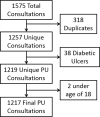Validation of two case definitions to identify pressure ulcers using hospital administrative data
- PMID: 28851785
- PMCID: PMC5629722
- DOI: 10.1136/bmjopen-2017-016438
Validation of two case definitions to identify pressure ulcers using hospital administrative data
Abstract
Objective: Pressure ulcer development is a quality of care indicator, as pressure ulcers are potentially preventable. Yet pressure ulcer is a leading cause of morbidity, discomfort and additional healthcare costs for inpatients. Methods are lacking for accurate surveillance of pressure ulcer in hospitals to track occurrences and evaluate care improvement strategies. The main study aim was to validate hospital discharge abstract database (DAD) in recording pressure ulcers against nursing consult reports, and to calculate prevalence of pressure ulcers in Alberta, Canada in DAD. We hypothesised that a more inclusive case definition for pressure ulcers would enhance validity of cases identified in administrative data for research and quality improvement purposes.
Setting: A cohort of patients with pressure ulcers were identified from enterostomal (ET) nursing consult documents at a large university hospital in 2011.
Participants: There were 1217 patients with pressure ulcers in ET nursing documentation that were linked to a corresponding record in DAD to validate DAD for correct and accurate identification of pressure ulcer occurrence, using two case definitions for pressure ulcer.
Results: Using pressure ulcer definition 1 (7 codes), prevalence was 1.4%, and using definition 2 (29 codes), prevalence was 4.2% after adjusting for misclassifications. The results were lower than expected. Definition 1 sensitivity was 27.7% and specificity was 98.8%, while definition 2 sensitivity was 32.8% and specificity was 95.9%. Pressure ulcer in both DAD and ET consultation increased with age, number of comorbidities and length of stay.
Conclusion: DAD underestimate pressure ulcer prevalence. Since various codes are used to record pressure ulcers in DAD, the case definition with more codes captures more pressure ulcer cases, and may be useful for monitoring facility trends. However, low sensitivity suggests that this data source may not be accurate for determining overall prevalence, and should be cautiously compared with other prevalence studies.
Keywords: administrative data; healthcare; patient safety indicator; pressure injury; pressure ulcer; validation studies.
© Article author(s) (or their employer(s) unless otherwise stated in the text of the article) 2017. All rights reserved. No commercial use is permitted unless otherwise expressly granted.
Conflict of interest statement
Competing interests: None declared.
Figures
References
-
- Redelings MD, Lee NE, Sorvillo F. Pressure ulcers: more lethal than we thought? Adv Skin Wound Care 2005;18:367–72. - PubMed
-
- Panel N. NPUAP pressure ulcer stages/Categories. http://www.npuap.org/resources/educational-and-clinical-resources/npuap-....
-
- Woodbury MG, Houghton PE. Prevalence of pressure ulcers in Canadian healthcare settings. Ostomy Wound Manage 2004;50:22–39. - PubMed
-
- Cuddigan J, Berlowitz DR, Ayello EA. Pressure ulcers in America: prevalence, incidence, and implications for the future. Advances in Skin & Wound Care 2001;14:208. - PubMed
Publication types
MeSH terms
LinkOut - more resources
Full Text Sources
Other Literature Sources
Medical

